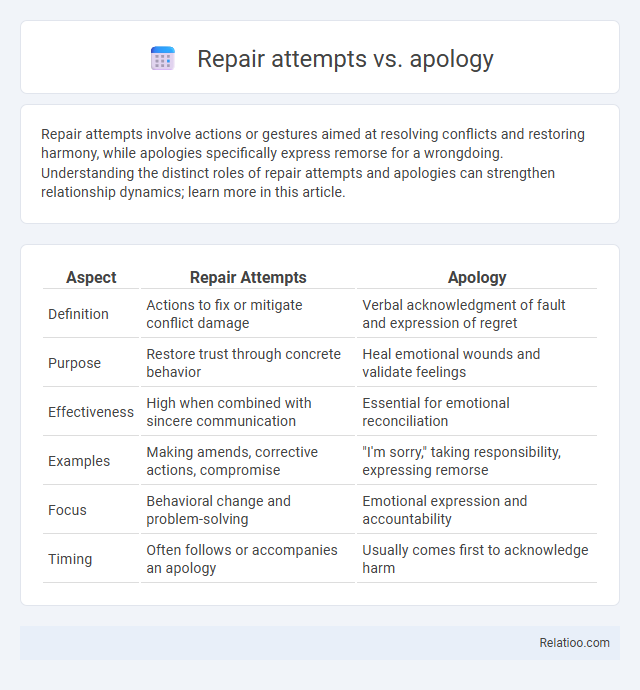Repair attempts involve actions or gestures aimed at resolving conflicts and restoring harmony, while apologies specifically express remorse for a wrongdoing. Understanding the distinct roles of repair attempts and apologies can strengthen relationship dynamics; learn more in this article.
Table of Comparison
| Aspect | Repair Attempts | Apology |
|---|---|---|
| Definition | Actions to fix or mitigate conflict damage | Verbal acknowledgment of fault and expression of regret |
| Purpose | Restore trust through concrete behavior | Heal emotional wounds and validate feelings |
| Effectiveness | High when combined with sincere communication | Essential for emotional reconciliation |
| Examples | Making amends, corrective actions, compromise | "I'm sorry," taking responsibility, expressing remorse |
| Focus | Behavioral change and problem-solving | Emotional expression and accountability |
| Timing | Often follows or accompanies an apology | Usually comes first to acknowledge harm |
Understanding Repair Attempts: Definition and Importance
Repair attempts are communicative strategies used to address and resolve misunderstandings or errors in conversation, ensuring mutual comprehension. These attempts are crucial for maintaining effective dialogue and social harmony by clarifying ambiguous statements or correcting mistakes. Understanding repair attempts helps in analyzing conversational dynamics and improving communication skills in various interpersonal and professional contexts.
The Psychology Behind Apologies and Repair Attempts
Repair attempts are essential behaviors in interpersonal conflicts aimed at correcting misunderstandings and restoring trust, while apologies serve as explicit acknowledgments of wrongdoing that facilitate emotional healing. Psychological research highlights that effective repair attempts often combine verbal apologies with nonverbal cues, signaling genuine remorse and empathy, which enhances relational satisfaction and conflict resolution. The interplay between sincere apologies and strategic repair attempts reduces defensive responses and promotes forgiveness by addressing both emotional and cognitive aspects of reconciliation.
Key Differences Between Apology and Repair Attempts
Apology primarily involves acknowledging fault and expressing regret, which serves to address emotional harm and restore trust. Repair attempts, on the other hand, extend beyond verbal expressions by incorporating actions that aim to correct the wrongdoing and prevent future issues. The key difference lies in apologies focusing on verbal responsibility and empathy, while repair attempts emphasize concrete behavioral changes and restitution.
When to Use a Repair Attempt vs. an Apology
Repair attempts involve actions or statements aimed at resolving a conflict or misunderstanding, whereas apologies explicitly acknowledge fault and express regret. You should use a repair attempt when the goal is to clarify intentions or correct a specific issue without necessarily admitting blame, reserving apologies for situations where taking responsibility and expressing remorse is essential. Effective communication often combines both, but knowing when to prioritize a repair attempt versus an apology enhances relationship repair and conflict resolution.
Emotional Impact: Repair Attempts vs. Apology
Repair attempts often involve specific actions aimed at resolving a conflict, which can significantly reduce emotional distress by demonstrating commitment to change. Apologies primarily address emotional wounds through verbal acknowledgment of wrongdoing, fostering forgiveness and emotional healing. Combining repair attempts with sincere apologies maximizes emotional impact, promoting trust restoration and relational resilience.
Common Misconceptions About Apologies and Repair Attempts
Many people mistakenly believe that apologies alone resolve conflicts, overlooking the importance of repair attempts that actively address the harm caused. Repair attempts involve concrete actions or changes demonstrating accountability, which differ from apologies that often only express remorse verbally. Effective conflict resolution relies on combining sincere apologies with meaningful repair attempts to rebuild trust and restore relationships.
Effectiveness in Conflict Resolution: Repair Attempts vs. Apology
Repair attempts directly address the emotional impact of a conflict by validating feelings and expressing understanding, often leading to more effective conflict resolution than a simple apology. While an apology acknowledges wrongdoing, repair attempts actively work to rebuild trust and soothe relational tensions, resulting in a stronger emotional connection. You can enhance your conflict resolution by combining sincere apologies with meaningful repair attempts that demonstrate empathy and commitment to change.
Cultural Perspectives on Repair Attempts and Apologies
Cultural perspectives on repair attempts and apologies vary significantly, influencing how individuals perceive accountability and reconciliation. In some cultures, a sincere apology may be prioritized over repair attempts as a way to restore social harmony, while others emphasize tangible repair actions to demonstrate responsibility. Understanding these cultural nuances helps you effectively navigate interpersonal conflicts and foster meaningful resolutions across diverse settings.
Practical Tips for Successful Repair Attempts
Effective repair attempts in communication involve acknowledging the issue and expressing a sincere apology to rebuild trust. Practical tips include using clear, empathetic language and actively listening to the other party's concerns to demonstrate genuine understanding. Consistent follow-up actions reinforce the repair, ensuring that apologies lead to meaningful resolution and strengthened relationships.
Integrating Apologies and Repair Attempts for Stronger Relationships
Integrating apologies and repair attempts enhances interpersonal trust by addressing both emotional acknowledgment and constructive problem-solving. Effective apologies validate feelings and take responsibility, while repair attempts actively resolve conflicts and prevent recurrence. Combining these elements fosters deeper empathy, reduces relational tension, and builds stronger, more resilient connections.

Infographic: Repair attempts vs Apology
 relatioo.com
relatioo.com